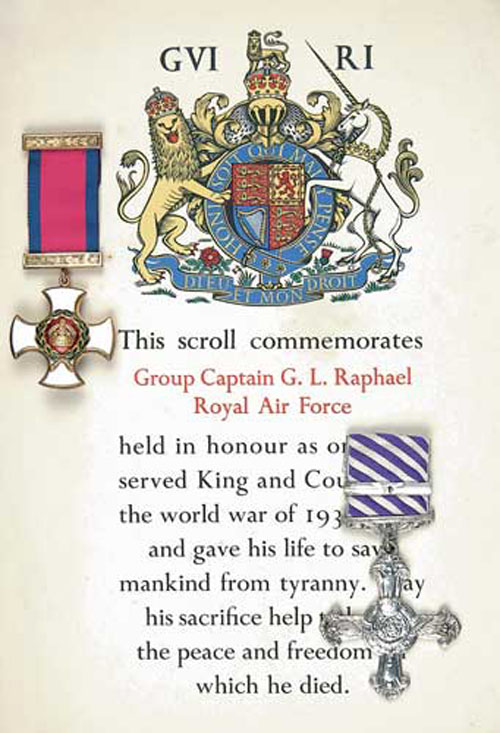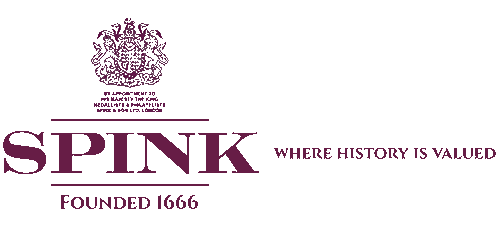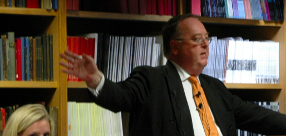
Auction: 6025 - Orders, Decorations, Campaign Medals & Militaria
Lot: 245
A Second War D.S.O., ´Immediate´ D.F.C., and Bar Group of Six to Bomber Pilot, Later Night Fighter Ace With Seven British Airspace Victories Group Captain G.L. ´Raffy´ Raphael, Royal Air Force, Who Was Tragically Killed in a Mid-Air Collision, in April 1945 a) Distinguished Service Order, G.VI.R., silver-gilt and enamel, reverse of suspension bar officially dated ´1943´, with top riband bar b) Distinguished Flying Cross, G.VI.R., lower arm of reverse officially dated ´1940´, with Second Award Bar, reverse officially dated ´1941´ c) 1939-1945 Star d) Air Crew Europe Star e) War Medal, M.I.D. Oak Leaf f) Canadian Memorial Cross, G.VI.R., reverse officially engraved ´G.C. G.L. Raphael D.S.O., D.F.C. & Bar RAF 37508´, with ring suspension, extremely fine; together with British War Medal (Capt. H.M. Raphael.), minor edge bruise, otherwise extremely fine (7) with the following related items: - serial plate from a Junker 88 that recipient shot down; - wooden plaque bearing the motto of 841 Naval Air Squadron, presented to the recipient by the squadron; - Raphael´s wife´s flying helmet, leather and metal fittings; recipient´s R.A.F. (2) cloth wings and riband bar -with the following archive of documents: - Bestowal document for the Distinguished Service Order, dated 2.2.1943 - Mentioned in Despatches Certificate, dated 20.1.1940 - Commission appointing G.L. Raphael as Acting Pilot Officer, Royal Air Force, dated 20.3.1936 - Second War Parchment Memorial Scroll - Named Investiture invitation; Record of Service, Educational and Professional Qualifications Certificate; congratulatory telegrams including one from Air Marshal ´Billy´ Bishop, V.C., dated February 1943, official and family war time correspondence; a quantity of photographs; (2) copies of Air Aces by G. Anthony, in which the recipient is featured, and other ephemera (lot) Estimate £ 10,000-12,000D.S.O. London Gazette 2.2.1943 37508 Wing Commander Gordon Learmouth Raphael, D.F.C., 85 Sqn, The Recommendation states, ´Since receiving a bar to his D.F.C. (London Gazette 15.7.41) W/Cdr. Raphael has destroyed three more enemy aircraft at night and damaged another. On the night of 13/14th July 1941 he destroyed a Henikel III which was seen to hit the sea in flames about 15 miles East of Clacton. On the night of 16/17th September 1941 he destroyed a Ju 88 which crashed into the sea in flames just East of Clacton, three members of the crew baling out and being apprehended at Clacton. On the night of 30/31st July 1942 he damaged a Ju 88 South of Cambridge. Two bursts of 2 and half seconds each were fired and many strikes were seen. On the night of 2/3rd August 1942 he fired a 5 seconds burst at less than 100 yards range at a Ju 88 which caught fire and crashed in flames near Dengie Flats. The above combats were carried out in Havoc night fighters. Wing Commander Raphael has commanded No. 85 Squadron since the end of May 1942. During the last four months when enemy activity at night over this country has been almost negligible he has maintained an extremely high morale in his Squadron. This he has done by his hard work, keenness in efficiency, and by keeping his aircraft in a high state of serviceability and readiness. When the Squadron was re-equipped with Mosquitoes, the change-over was done with extreme smoothness. The high serviceability was still maintained and the Squadrons became operational on their new type in a very short space of time. Wing Commander Raphael himself gave dual instruction to a large number of his pilots. Again he maintained a high state of serviceability of Mosquitoes and has continued to do so. Wing Commander Raphael has at all times had the welfare and comfort of his pilots and ground crews at heart and has worked hard and solely for the efficiency and well being of his Squadron, both from an operational point of view and a welfare point of view. He has proved himself an outstanding Squadron Commander of great personality and offensive spirit. His D.F.C. was awarded him in May 1940 (Bomber Command). Bar to D.F.C. in July 1941 (85 Squadron). His successes are 8 destroyed (2 with Bomber Command) all at night. 1 probably destroyed. 1 damaged.´ D.F.C. London Gazette 17.5.1940 37508 Flying Officer Gordon Learmouth Raphael 77 Sqn, The Recommendation states, ´As Captain of a Whitley aircraft engaged on a Nickel flight to Warsaw on the night 15/16th March 1940, this officer carried out his task with a precision and exactness that has marked all his operational flights. His teamwork in the air, his meticulous planning before a flight, his ability as a pilot and navigator and his complete knowledge of his equipment makes all his flights appear simple and uneventful. The flight to Warsaw, in spite of an increase in wind speed when going to the target and dense clouds on the return journey, was completed with a deviation from schedule which can be accounted for almost to a minute by the increased wind speed. Throughout the period of the present hostilities this officer has shown skill, daring and initiative on all his flights. Previous flights include a nickel raid on Posen, as well as several security patrols, reconnaissance and nickel raids on other German towns.´ D.F.C. Second Award Bar London Gazette 15.7.1941 37508 Flight Lieutenant Gordon Learmouth Raphael, D.F.C., 85 Sqn, The Recommendation states, ´This officer has performed magnificent work in the course of recent night flying operations. Since May 3rd, 1941, when he joined the Squadron F/Lt. Raphael has destroyed three enemy aircraft and probably destroyed another. On the night of May 10/11th he shot down a HE111 in flames which crashed near Chelmsford. On the night of June 13/14th he attacked and probably destroyed a HE111 which was last seen going down completely out of control east of Shoeburyness. A few minutes afterwards he attacked another HE111 near Gravesend which exploded in mid air. In both these combats he pressed home his attacks with great determination in the face of intense return fire. On the night of June 24/25th F/Lt. Raphael destroyed a JU 88 after making three separate attacks. In breaking away after the first attack he received intense and accurate return fire from the enemy aircraft which hit his Havoc in many places including the starboard engine, oil tank, and fuselage. In spite of this F/Lt. Raphael delivered a second attack which silenced the rear gunner and a third attack which stopped the engines of the JU 88. F/Lt. Raphael has proved himself to be a relentless and skilful night fighter pilot and his example has been a source of encouragement to his fellow pilots.´ M.I.D. London Gazette 2.2.1940 Flying Officer G.L. Raphael (37508) M.I.D. London Gazette 1.1.1945 Group Captain G.L. Raphael, D.S.O., D.F.C. (37508) R.A.F.O. Group Captain Gordon Learmouth ´Raffy´ Raphael, D.S.O., D.F.C., born Brantford, Ontario, Canada, 25.8.1915; moved to Quebec at an early age and was educated at Shawinigan School and the High School of Quebec; he left Canada for England and attended the Chelsea Aeronautic College, 1934; enlisted as No. 700284 Aircraftman 2nd Class Royal Air Force Volunteer Reserve, 30.9.1935; Sergeant 1.10.1935; Acting Pilot Officer Royal Air Force, 16.12.1935; posted to No. 10 Flying Training School, 1.2.1936, before serving with 7 (B) Squadron, Worthdown, Hampshire (Handley Page Heyfords), 10.8.1936 and 77 (B) Squadron, Dishforth, Yorkshire (Heyfords and then Whitleys), 20.3.1937-28.11.1938; Flying Officer 16.6.1938; posted 77 (B) Squadron, Driffield, Yorkshire, (Whitleys) 1.6.1939, with whom he flew in the early leaflet raids over Germany, ´ "Those were curious days. We didn´t know what to expect, because nobody had ever done night raids on Germany and I remember that the first time we went over we were quite certain we would be shot down"....... Raphael was on the first leaflet raid of the War - over the Ruhr - and he and his crew used to liven up the evening by permitting the rear gunner to fire at searchlights. "We accounted for between 50 and 60 searchlights altogether." ´ (Chronicle Telegraph, Canada refers); other operations included: the first attack on Trondheim seaplane base; Oslo airfield after the invasion of Norway and Warsaw, ´ "Then I stuck my neck out. I was feeling so good about getting a ´gong´ [D.F.C. London Gazette 17.5.1940] that I asked to be allowed to fly again the next night, although it wasn´t my turn. We were going after an oil refinery [Hanover], and our machine was first over the target to drop incendiaries and light it up for the later arrivals. On the way back, we were attacked by a Jerry over the North Sea. He shot out both my engines and busted the hydraulic system. But my rear gunner got him and he went down in flames. We had to land in the sea; that made a couple of "first times" on this trip. It was the first time a Whitley had shot down an enemy night fighter, and the first time a Whitley had been put down in the sea with all the crew unhurt. My crew really got out in a hurry when we hit the water; I was a bit slower because I discovered that a bullet from the enemy´s guns had gone through both my feet. However we got the dinghy out and didn´t discover until later that we had upside down. We were picked up by a British destroyer [H.M.S. Javelin] and I spent a couple of comfortable days in the sick bay. When I got ashore, I had to spend three months recuperating. This was a bit annoying, because it meant that I missed a lot of good shows." ´ (Chronicle Telegraph refers); Flight Lieutenant 16.6.1940; posted 10 Squadron, Dishforth, Yorkshire (Whitleys), 12.7.1940; converted to Fighter Command and was posted as Flight Commander 96 Squadron, Cranage (Hurricanes), 18.1.1941; transferred 85 (Night Fighter) Squadron, Debden and subsequent move to Hunsdon (Havocs and Mosquitoes), 2.5.1941 with whom he was immediately successful, ´His first victory in this game was during the big blitz on London on May 10th, the last time that the Luftwaffe attacked Britain in force. It was the night when Britain´s defence against night bombing brought down 33 German raiders. "Raffy´s" victim was a Heinkel III" (Newspaper Cutting included in the lot refers); Raphael claimed four victories and a probable by the end of the year; Temporary Squadron Leader 1.9.1941; promoted Officer Commanding 85 Squadron, 27.5.1942, following in the foot steps of another decorated Canadian, Air Marshal "Billy" Bishop, V.C., who had commanded the famous ´Dawn Patrol´ Squadron during the Great War, ´We have tried to keep up the Bishop tradition..... Our Squadron emblem is still the white hexagon painted on the old S.E. 5´s which the Squadron had when Bishop commanded it in the last war´ (Raphael Interview, Newspaper cutting included in the lot refers); Raphael proved a dedicated leader who disapproved of anything that may affect the reflexes or ability of his men in combat, his commitment inspired his men, ´Unless a Hun machine comes over every night, the boys are pretty disgusted....... They just love to have a crack at him.´ (Raphael Interview, Newspaper cutting included in the lot refers); Squadron Leader 27.8.1942; during the remainder of his command of the squadron he recorded a further two victories and one damaged; posted as Station Commander R.A.F. Castle Camps, 28.1.1942 before filling the same post at R.A.F. Manston, 18.4.1943; whilst commanding the latter he shot down two V-1 Rockets, ´Although off operational flying for over a year now, Wing Commander Raphael went out to lend his leadership and experience to the defence against this latest German method of attack. As proof that he has lost none of the skill that made him one of the deadliest fighters of the war he knocked down one of the flying bombs in his first effort´ (Raphael Interview, Newspaper cutting included in the lot refers); posted Acting Group Captain and Station Commander Biggin Hill, 15.2.1945; Group Captain G.L. Raphael was killed on active service when the Spitfire that he was flying collided mid-air with a Dakota, 10.4.1945, he is buried at Cudham (SS. Peter and Paul) Churchyard, Orpington.
Sold for
£12,000




